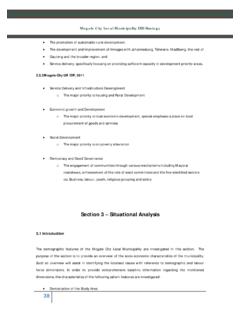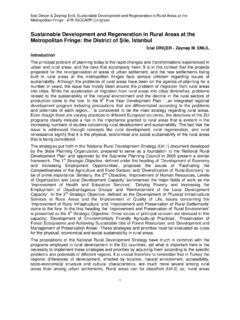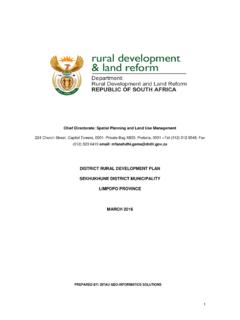Transcription of Sustainable Rural Housing - National Spatial Strategy
1 Sustainable Rural HousingGuidelines for Planning AuthoritiesApril 2005 Government of IrelandBAILE THA CLIATHARNA FHOILSI AG OIFIG AN tSOL THAIRLe ceannach d reach nOIFIG DH OLTA FOILSEACH N RIALTAISTEACH SUN ALLIANCE, SR ID THEACH LAIGHEAN, BAILE THA CLIATH 2,n tr d an bpost FOILSEACH IN RIALTAIS, AN RANN G POST-TR CHTA,51 FAICHE STIABHNA, BAILE THA CLIATH 2,(Teil: 01 - 6476834/35/36/37; Fax: 01 - 6476843)n tr aon d olt ir BY THE STATIONERY OFFICETo be purchased directly from theGOVERNMENT PUBLICATIONS SALE OFFICESUN ALLIANCE HOUSE, MOLESWORTH STREET, DUBLIN 2,or by mail order fromGOVERNMENT PUBLICATIONS, POSTAL TRADE SECTION,51 ST. STEPHEN S GREEN, DUBLIN 2,(Tel: 01 - 6476834/35/36/37; Fax: 01 - 6476843)or through any April, 2005 Prn A5/0535 Planning GuidelinesMinister s ForewardI would like to thank sincerely the morethan 100 organisations and individualswho made submissions on the draftplanning guidelines on Sustainable RuralHousing published last of your submissions were broadlysupportive of the draft guidelines.
2 Many of your suggestions havebeen included in the finalised guidelines. In particular, there is arenewed and strengthened emphasis in the guidelines on improvingthe service from planning authorities to applicants, with particularreference to improving the availability and responsiveness of pre-planning consultations. This will ensure that applicants andplanning authorities can work together, on the basis of clear andobjective planning criteria, to select the best available site for ahouse and the best design solution for that site. In this regard it ismost important that people have a better understanding of planningissues and that planning officials listen and respond to the concernsof was also particularly anxious to ensure that the guidelines madeabsolutely clear that returning emigrants who were born and livedfor substantial parts of their lives in Rural areas and who thenmoved abroad, and who now wish to return to their home-placesto reside near other family members, to work locally, to care forelderly family members, or to retire should have their housingrequirements facilitated on their organisations who manage the development process in ruralareas, such as Planning Authorities and an Bord Pleanala.
3 Alsomade submissions containing helpful suggestions to improve thepractical implementation of the guidelines in the developmentplan process and in the day-to-day operation of the planningsystem. Many of these suggestions have also been incorporatedin the final GuidelinesI believe these guidelines usher in a new era which enables planningauthorities to respond positively to the Housing needs of ruralcommunities as an integral part of the Sustainable development ofrural areas and which accommodates applicants wishing to buildhouses in Rural areas in support of that vital National Roche for the Environment, Heritage and Local GuidelinesContentsPage NoIntroduction1 Chapter 1. Background to RuralHousing Guidelines under the Planning and development Act Policy Context3 Chapter 2. Policy Aims Sustaining and Renewing Established Rural Strengthening Rural Villages and Guiding Tailoring Planning Policies to Local Circumstances 12 Chapter 3.
4 Rural Housing and theDevelopment development Plan Identifying Rural Area Suggested Holiday and Second Home development Rural Generated Other Objectives and Landscape, Natural and Cultural Features Natural Siting and Transport28 Planning GuidelinesChapter 4. Rural Housing and Planning Application Improving Services to Assessing Housing Protecting Water Natural and Cultural Occupancy Conclusion42 AppendicesAppendix 1: Indicative Occupancy Conditions43 Appendix 2: Supplementary Information on Heritage 44 Appendix 3: development Plan Objectives and Issues for Rural Areas51 Appendix 4: Ribbon Development55 Appendix 5: List of Submissions561 Planning GuidelinesIntroductionPolicies on Rural Housing must be responsive to the dispersedpatterns of settlement in Ireland.
5 According to the 2002 Census,around 40% of the Irish population overall lives in Rural areas,including smaller towns and villages. In some counties particularlyin parts of the midlands and in the west, a much higher proportionof households up to 70% - live in the open countryside. The 1997 policy document Sustainable development : A Strategyfor Ireland mapped out a strategic policy framework to delivermore Sustainable development . In dealing with Rural Housing thatStrategy referred to contrasts in development trends between ruralde-population in some areas and strong pressure for developmentof Housing in other Rural areas close to cities and towns. TheSustainable development Strategy indicated that there should bea presumption against urban-generated one-off Housing in ruralareas adjacent to towns. It became clear by the time the National Spatial Strategy (NSS)was being prepared that these provisions were sometimes operatedover-rigidly.
6 The NSS accordingly set Rural Housing policy in abroader and more flexible context, superseding the 1997 on the Rural policy framework in the NSS theseguidelines provide that: People who are part of the Rural community should befacilitated by the planning system in all Rural areas, includingthose under strong urban-based pressures, Anyone wishing to build a house in Rural areas sufferingpersistent and substantial population decline will beaccommodated, The development of the Rural environs of major urban areas,including the gateways and hubs identified in the NSS andcounty and other larger towns over 5000 in population needsto be carefully managed in order to assure their orderlydevelopment and successful functioning into the principles set out in these guidelines also require that newhouses in Rural areas be sited and designed to integrate well withtheir physical surroundings and be generally compatible with.
7 2 Planning Guidelines(1) The protection of water quality in the arrangements madefor on site wastewater disposal facilities;(2) The provision of a safe means of access in relation to roadand public safety;(3) The conservation of sensitive areas such as natural habitats,the environs of protected structures and other aspects ofheritage. The Guidelines make it clear that statutory designation of certainrural areas [ Special Areas of Conservation (SACs), SpecialProtection Areas (SPAs) and National Heritage Areas (NHAs)] isnot intended in any way to operate as an inflexible obstacle assuch to Housing development . In considering developmentproposals, including the attachment of planning conditions, insuch areas, planning authorities should only consider approvingproposals they are satisfied will not adversely affect the integrityof the designated area. Acknowledging the trends for development of holiday homes insome coastal, scenic and lakeside parts of the country, the guidelinesemphasise the importance of clustering such tourism driven activity,as far as possible, in well designed and appropriately scaleddevelopments in or adjoining small towns and villages.
8 In thisregard, it is vital that development trends in relation to holidayhomes in Rural areas be closely monitored and responded to inorder to avoid negative guidelines set out in detail how the Government s policieson Rural Housing are to be implemented by planning authoritiesin making their development plans and in the operation of thedevelopment control system to ensure a vibrant future for all ruralareas. All planning authorities should take immediate steps to reviewtheir development plans with a view to incorporating any changesnecessary to ensure that development plan policies are consistentwith the policies set out in these GuidelinesChapter 1: Background toRural Housing Guidelines Guidelines under the Planning and development Act 2000 These guidelines constitute Ministerial guidelines under Section28 of the Planning and development Act 2000.
9 Section 28 providesthat planning authorities and An Bord Pleanala shall have regardto Ministerial guidelines in the performance of their functions. Policy ContextIreland has a long tradition of people living in Rural areas. Accordingto the 2002 census, around 40% of the total National populationlived in Rural areas, these being defined for the purposes of theseguidelines as those areas outside of urban areas with a populationof 1500 and over. The 2002 census also shows widely varying trends in relation tothe population levels in different types of Rural areas. Rural areasclose to cities and some larger towns, those close to nationallyimportant transport corridors linked to such cities and larger townsand those in certain more scenic areas are experiencing populationgrowth, with very substantial rates of growth in some cases. Othermore remote and economically weaker areas are experiencingpopulation government policies on planning for Housing in Rural areascame into effect with the publication of the National Spatial Strategyin NSS recognised the long tradition of people living in ruralparts of Ireland and promotes Sustainable Rural settlement as akey component of delivering more balanced regional development .
10 The NSS called for settlement policies in development plans andtheir implementation in the administration of planning to takeinto account both the differing demands for Housing in Rural areas4 Planning Guidelinesand varying Rural development contexts. Different policies areneeded, for example, for areas with declining populations ascompared with areas in which there are overspill issues associatedwith proximity to large cities or towns. The Sustainable Rural settlement policy framework in the NSS hasfour broad objectives:(1) To sustain and renew established Rural communities andthe existing stock of investment in a way that responds tothe various Spatial , structural and economic changes takingplace, while protecting the important assets Rural areaspossess.(2) To strengthen the established structure of villages and smallersettlements both to support local economies and toaccommodate additional population in a way that supportsthe viability of public transport and local infrastructure andservices such as schools and water services.






